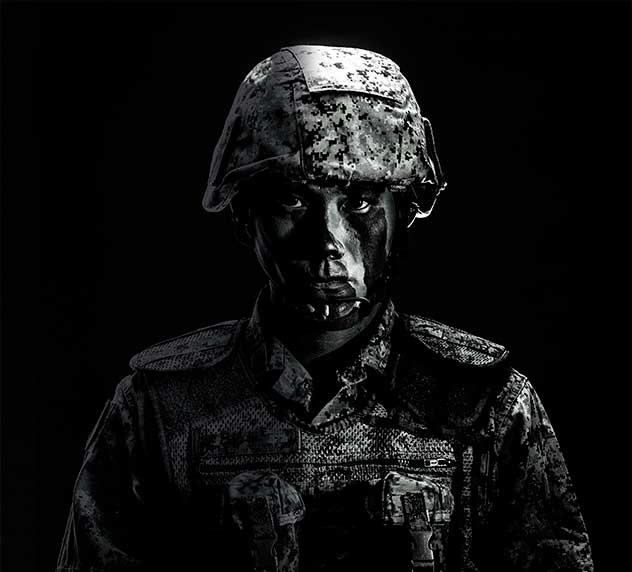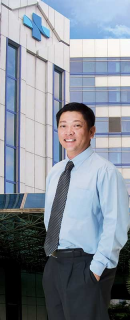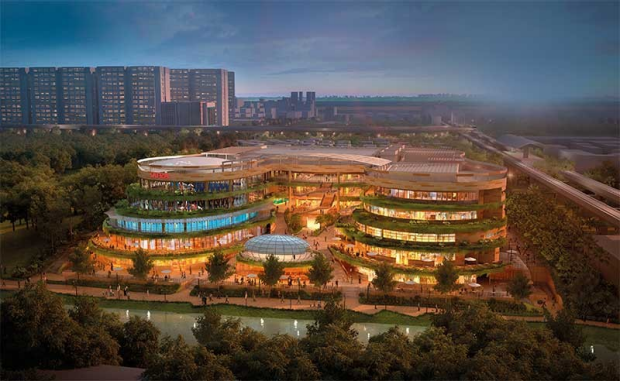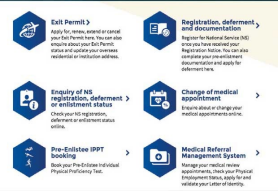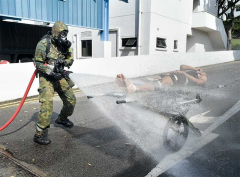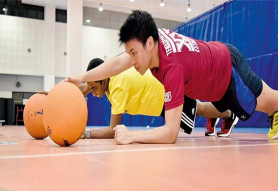With the growing threat of terrorism, no nation is truly safe. The Islamic State in Iraq and Syria (ISIS), an armed terror group, has carried out or inspired more than 70 attacks in 20 countries other than Iraq and Syria, according to a CNN report.
Even neighbouring countries such as Malaysia and Indonesia, with majority Muslim populations, have been targeted. At the start of the year, Jakarta was rocked by a terrorist attack, for which ISIS claimed responsibility. The bomb and gun attacks left eight people dead, including all four attackers. At least 20 people were wounded.
In Malaysia, the police have arrested over 100 individuals suspected to be linked to ISIS since 2014. Seven people were apprehended in January for harbouring plans to launch attacks in strategic locations across Malaysia.
Over in Singapore, the Internal Security Department arrested 27 Bangladeshi workers late last year. They were planning to take part in extremist activities in other countries, including their home country.
To help tackle the growing threat, the SAF joined 33 other countries in the United States (US)-led coalition in the fight against ISIS last year.
In November 2014, Minister for Defence Dr Ng Eng Hen explained in Parliament that the deployment was necessary as terrorist groups based in countries far away could still pose a danger to Singapore.
"By contributing to the international effort to tackle the threat at (the) source, we're contributing directly to our own security."
Over the past year, the SAF deployed Intelligence Fusion Officers and an Imagery Analysis Team to the Middle East to provide intelligence analysis support.
The support was vital in monitoring ISIS activities and targeting their strongholds in Iraq and Syria. A Republic of Singapore Air Force (RSAF) KC-135R air-to-air refuelling tanker was also deployed to perform refuelling operations for coalition aircraft.
At the Overseas Service Medal presentation ceremony held in January, where 76 SAF personnel were recognised for their counter-ISIS efforts, Dr Ng said: "We join this fight because if we do not triumph over extremist terrorism, the danger and risks to our citizens here will only grow.
"As Jakarta and the rest of Malaysia show, if the danger is brought to our doorstep, I expect all SAF units to be alert and to see this as part of your core mission to protect citizens here."
Battle over minds
In recent years, ISIS has been using social media to spread radical ideology based on false religious teachings with significant success.
This is a facet of hybrid warfare: the use of conventional weapons and unconventional tools, such as spreading disinformation, to achieve victory without an open war.
Singapore is not immune. Last May, authorities detained a 19-year-old self-radicalised Singaporean student, Arifil Azim Putra Norja'I, who was planning to join ISIS and carry out attacks here. Another radicalised youth, aged 17, was arrested for further investigations.
Separately, four Singaporeans were arrested under the Internal Security Act in March, for involvement in armed violence overseas. Three of the four men had performed armed duties in Yemen, while the fourth was on his way to join a Kurdish militia.
Dr Ng said the way to respond is through Total Defence (TD) where every citizen stays alert. For example, a friend of Arifil had noticed the change in him and alerted the authorities. This led to his arrest.
"This is something which is occurring here and now, something that has changed the battlefield. So it's a battle over mind, it's a battle over ideology," Dr Ng said at the Kent Ridge Ministerial Forum last August.
To strengthen Singapore's unity and resilience as a nation, this year's TD campaign had a renewed emphasis on social and psychological defence.
At the TD Day Commemoration event on 15 Feb, Senior Minister of State for Defence Dr Mohamad Maliki Bin Osman noted that both the SAF and the Home Team were stepping up efforts to protect Singapore against terrorism, but "this fight is not for security agencies alone".
"The fight involves every one of us - regardless of our race or religion - all coming together to make a firm stand against any group that threatens to destroy our way of life," he said.
Homeland security
To guard against terror attacks, the SAF and other national security agencies have stepped up security measures, intelligence-gathering efforts and border controls.
The SAF is beefing up its cyber defence capabilities to guard against the hacking of Singapore's critical sectors. More servicemen, including Operationally Ready National Servicemen (NSmen), will be deployed to the Cyber Defence Operations Hub.
In May 2015, the SAF and key national agencies tested their readiness in Exercise Northstar 9.The drill tested the agencies' response to bomb and chemical attacks at a mass event held at the Sports Hub. The SAF deployed soldiers from the Chemical, Biological, Radiological and Explosives Defence Group and the Medical Response Force (MRF) for the exercise.
Speaking to the media after watching the exercise, Prime Minister Lee Hsien Loong said: "We have to be very vigilant, and we have to practise our response capabilities This means all our agencies have to work together to respond coherently.
"I'm glad that the different agencies are working together. We've the SCDF (Singapore Civil Defence Force), the Police, and the SAF bomb disposal unit (here today). I think it has worked well."
At Exercise Highcrest 2015, the Singapore Maritime Crisis Centre orchestrated a multi-agency response to simultaneous threats in the seas.
Nine hundred personnel from 15 agencies, including the SAF, Singapore Police Force, and Maritime and Port Authority of Singapore were involved.
The exercise saw the Republic of Singapore Navy (RSN) and Police Coast Guard intercepting a terrorist speedboat, and the SAF's Special Operations Task Force descending from an RSAF Super Puma helicopter to storm a hijacked merchant ship.
On how the drills helped to boost the various units' confidence in operating together, exercise participant Military Expert (ME) 1 Eswaran s/o Kaliapermal said: "It helps us to tie down the procedures and also firm up the communication protocols.
"On the ground, it helps to make us more capable and able to deal with such situations, should they arise."
The Army's standby units also demonstrated their high state of readiness during an activation exercise at Amoy Quee Camp last November. About 500 soldiers from 2nd Battalion, Singapore Infantry Regiment (2 SIR) assembled with their weapons and equipment within minutes of being activated.
Senior Minister of State for Defence Ong Ye Kung, who observed the exercise, said: "What you see today is a sample of what we can do and how we are getting ready to protect ourselves against terrorist threats and other threats. Over the years, the SAF has built itself into a strong defence force, capable of handling external enemies or terrorists."
The SAF's track record speaks for itself. In 1991, SAF Commandos stormed the hijacked airplane SQ117 and freed all 125 passengers and crew.
During the 1974 Laju incident, a 12-man team made up of four SAF Commandos and eight government officials played a key role in freeing three civilians who were taken hostage by terrorists.
Forging friendship
Singapore inked an enhanced defence agreement with the US, a longstanding defence partner, last December. Both sides will collaborate in the areas of Humanitarian Assistance and Disaster Relief (HADR), cyber defence, biosecurity and public communications.
Good progress has also been made in initiatives under earlier defence pacts. The US successfully deployed its second Littoral Combat Ship to Singapore in 2014, and, for the first time, the P-8 Poseidon aircraft last December. These deployments provided timely support for regional HADR and maritime security efforts.
The RSN and the People's Liberation Army (Navy) took the first step in enhancing bilateral ties, with the inaugural Exercise Maritime Cooperation which took place last May. The exercise came on the back of the Four-Point Consensus agreed on by Dr Ng and Chinese Minister of National Defence General Chang Wanquan in November 2014. It laid out how Singapore and China planned to strengthen bilateral defence cooperation.
At the 9th ASEAN Defence Ministers' Meeting (ADMM), defence ministers from the member countries noted with serious concern the brutality of ISIS.
To step up the fight against terror, Singapore will co-host the ADMM-Plus Maritime Security and Counter-Terrorism Exercise with Brunei, Australia and New Zealand in May.
The ADMM-Plus brings together ASEAN and its eight "Plus" partners - Australia, China, India, Japan, Republic of Korea, New Zealand, Russia and the US.
"We have to be very vigilant, and we have to practise our response capabilities... This means all our agencies have to work together to respond coherently." - PM Lee Hsien Loong at Exercise Northstar 9
Training space
Over the last 25 years, Australia has given the SAF access to vast training grounds to conduct the large-scale military exercise codenamed Wallaby. More than 4,000 personnel and 400 platforms took part in last year's edition.
Noting the benefits of the extensive training space in Australia, Dr Ng said: "It provides our armoured soldiers and national servicemen credible opportunities (and) very realistic training to hone their skills. This is very important (in building our) confidence and professionalism."
Both countries pledged to further enhance defence cooperation under the Comprehensive Strategic Partnership, and to conclude new initiatives such as stepping up intelligence sharing in the fight against terrorism.
The SAF medical team treating a Nepalese patient who sustained a leg injury in last year's earthquake.
Helping hand
Besides joining the global fight against ISIS, Singapore has also helped its international partners in several HADR operations.
When a massive 7.8-magnitude earthquake shook Nepal last April, the SAF deployed a team of medical personnel to provide much-needed medical care for the victims.
Personnel from the Changi Regional HADR Coordination Centre assisted the Nepalese Army in coordinating the multinational relief efforts. The Centre provided a real-time common operating picture that showed where help was needed most.
The RSAF's Chinook helicopter, with a 5,000-litre heli-bucket attached, discharged more than 400,000 litres of water and extinguished over 50 hotspots in Indonesia last year.
The RSAF's C-130 aircraft evacuated 71 Singaporeans and 24 foreigners from Nepal.
When haze shrouded Singapore and the region last year, a combined team from the SAF and SCDF helped to put out some of the hotspots in South Sumatra, Indonesia.
Dr Ng noted that the professional performance and operational readiness of the servicemen raised the standing of the SAF as a credible defence force.
"Many went beyond the call of duty and volunteered for these missions. This included an NSF (Full-time National Serviceman) who stepped forward to contribute to our firefighting efforts.
"I believe that both personally and as a unit, you have learnt many valuable operational lessons from these deployments that you should share with others."
The SAF is also undertaking its fourth command tour of the Combined Task Force 151 from 31 Mar, as part of counter-piracy operations in the Gulf of Aden.
Enhanced gear
To ensure that Singapore is able to protect itself from increasingly complex threats, the SAF has been steadily building up its military hardware over the years.
Soldiers patrolling key installations will now have better protection. The new Peacekeeper Protected Response Vehicle (PRV) comes with weapons that can be operated from within the safety of the armoured vehicle.
Following the recent commissioning of the Army Battlefield Internet (ABI), enhanced by the Software Defined Radio (SDR), soldiers can now get more detailed and timely information of the battlefield, and target enemies with greater precision. The SDR allows soldiers to communicate with their headquarters through voice communications and the sending of text, images and videos simultaneously.
For seaward defence, the RSN operates the Specialised Marine Craft (SMC), and will expand the fleet to eight by 2017.
The new Littoral Mission Vessels (LMVs) are expected to be fully operational by 2020. They are faster, and come with sharper capabilities than the current Fearless-class Patrol Vessels.
The LMV is two-and-a-half times bigger, but can be manned by a crew that is a quarter smaller. With Singapore's decreasing population, manpower consideration is a priority.
"The LMVs are uniquely Singaporean, having been planned, conceptualised and built locally to meet our requirements," said Dr Ng at the launch of the first LMV, Independence, last July. The RSN will add another seven LMVs to its fleet. The LMV was designed by local defence scientists and engineers. Over the years, they have helped the SAF to design, procure and customise various military hardware.
Honing combat capabilities
The SAF sharpens and validates its fighting tactics through realistic and complex large-scale training overseas.
In a first, the SAF successfully conducted an integrated live firing, where multiple sensor and shooter platforms combined to destroy multiple mobile targets in a single pass, at last year's Exercise Forging Sabre.
Held in Arizona, US, the wargame saw the Heron 1 Unmanned Aerial Vehicle (UAV) making its debut in this exercise series. It also involved RSAF assets such as the F-15SGs, the F-16C/Ds and the AH-64D Apache helicopters.
Dr Ng said the successful live firings were a "real confidence booster to the SAF and its integrated systems".
"I think very few militaries around the world train (in) as high tempo and with such complex scenarios as we do," he noted. "What we do at this level is not easy (but) we just have to keep doing it. The reason we do it is that the stronger we are, the easier it is to keep our peace."
Better training
The RSN launched a new Submarine Training Centre which comes equipped with simulators to provide realistic training in a safe environment. The submarine steering and diving simulator, for instance, mimics the movement of a real submarine.
To provide more upgrading options, the SAF and SCDF launched a new training and education roadmap which charts out the multiple upgrading pathways for paramedics.
Under the roadmap, they can attend courses offered by the Institute of Technical Education or the SAF, before pursuing higher studies in Nanyang Polytechnic or UniSIM. There is no Grade Point Average requirement for entry to these diploma and degree programmes.
Highlighting the SAF's push to certify skills servicemen have learnt, Mr Ong said: "So long as you are in a vocation, you can do the job (and) you are performing well, the path is open for you to seize."
Strengthening NS, recognising people
Two years ago, the Ministry of Defence (MINDEF) carried out an extensive public consultation involving more than 40,000 people to gather ideas on strengthening National Service (NS). Many of the 30 recommendations put up by the Committee to Strengthen NS have been implemented since, including the shortening of wait-time for enlistment.
The SAF Volunteer Corps has also been set up, providing women, first-generation Permanent Residents and new citizens with an avenue to contribute to the country's defence.
The inaugural cohort, numbering 226 volunteers, completed its basic training last June. They have taken on roles such as auxiliary security troopers, defence psychologists and naval platform engineers.
National servicemen were not forgotten, with the new Punggol SAFRA clubhouse opening in April to serve the 80,000-plus NSmen living in north-east Singapore.
"We have invested in building this clubhouse as a form of continuous recognition for our NSmen for all their contributions towards national defence," said Mr Ong during his tour of the construction site in January this year.
The support given to national servicemen by the broader community was not forgotten too.
Last year, the Advisory Council on Community Relations in Defence (ACCORD) put up 18 proposals to boost support and recognition for NS.
The Total Defence Award (TDA) was revamped to recognise not only large companies, but also small and medium-sized enterprises, schools, community organisations, and individuals such as family members and colleagues.
A winner of the NS Advocate Award for Individuals was Mr Chiu Wu Hong, an executive director in KPMG who went out of his way to ensure that his staff, Lieutenant (NS) Ho Kah Chuan, could attend all his In-Camp Training sessions. Mr Chiu helped to manage his projects and even negotiated with clients for deadline extensions.
Another ACCORD proposal was the pilot fitness programme to help students prepare for NS.
Four schools - Anderson Junior College, ITE College East and ITE College West and Temasek Polytechnic - started the programmes last July. Results have been encouraging. For example, the number of Temasek Polytechnic students who obtained a Pass with Incentive rose from 18 percent to 44 percent.
Standing together
Whether it is forging defence partnerships, keeping combat capabilities sharp, or providing better training for servicemen, the SAF does all this and more with only one aim in mind: keeping Singapore safe.
But the SAF cannot do this alone. Not without the support of all Singaporeans.
This year's TD campaign was themed Together We Keep Singapore Strong. Given the recent spate of terrorist attacks worldwide, the looming economic downturn, and a host of other challenges, this year's TD message was apt and timely. Singaporeans need to stay united - regardless of race and religion - to overcome the challenging times ahead.
While the SAF and the Home Team keep a close watch over key installations, they cannot be everywhere to cover soft targets such as shopping malls, coffee shops and schools. Singaporeans have to stay alert and look out for one another.
Deputy Prime Minister and coordinating Minister for National Security Teo Chee Hean made these points after visiting NSmen from 811 SIR who were guarding key installations in Jurong Island in February. "Perhaps you may even be able to take some important action to help contain and mitigate the consequences of an attack, so that the attacker cannot carry out what he wanted to do and reduce the damage and the casualties," he said.
Let's stay united, Singaporeans!
SGfuture: Keeping Singapore strong
Set aside a day each year to recognise the contributions of National Servicemen. Expand accreditation to cover more skills picked up during NS. These are some of the ideas that Singaporeans suggested to strengthen NS at a recent SGfuture engagement session.
The ongoing engagement is meant to give Singaporeans a voice in shaping the country's future.
In one of the sessions held earlier this year, participants discussed the changing threats that Singapore might face in the future. Another session saw participants brainstorming ways to celebrate 50 years of NS, which will take place in 2017.
